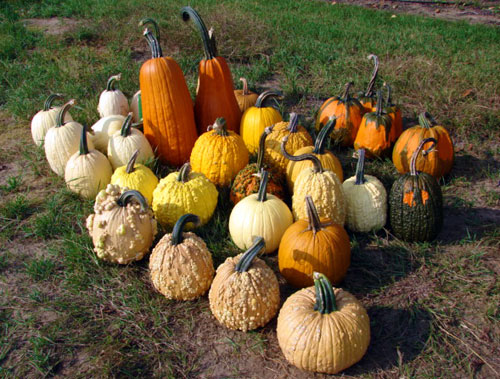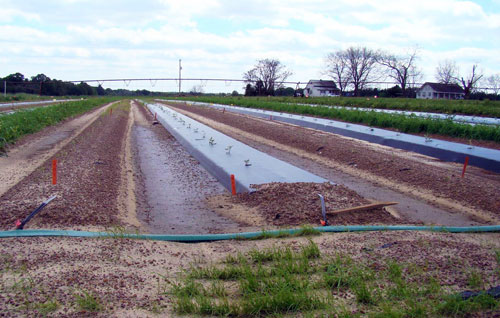Pumpkins and plastic: The pros and cons of plasticulture
Plasticulture has had a large impact on how many vine crops are produced. So why hasn’t it been used much in pumpkins?
Pumpkins have become an increasingly important crop for many commercial and direct market vegetable producers. Pumpkin season used to be primarily October, but now pumpkins are an important crop from early September through much of November. Jack-O-Lantern types are still preferred in October, but smaller, decorative varieties are popular up through Thanksgiving (Photo 1). Pumpkins are still produced primarily on bare ground even though their cousins – summer squash, watermelon and cantaloupe – are primarily produced in a plasticulture system. Why haven’t pumpkins made the switch?

Photo 1. Pumpkins come in a wide variety of colors, shapes, sizes and
appearances. Photo credit: Ron Goldy, MSUE
Two possible reasons may be due to pumpkin’s lower value and that there was no benefit for earlier harvest afforded by the additional input. However, markets are changing and pumpkin prices can approach those of watermelon. Any price difference would be somewhat offset by the added benefits of water and nutrient efficiency and weed control offered by the plastic mulch and drip irrigation. Production inputs for plasticulture pumpkins would be similar to watermelon since spacing, pest control and harvest techniques would be similar.
Another reason may be that some pumpkin growers use no-till techniques that do not lend themselves to plasticulture. These growers plant rye the previous fall and then roll it over in May, covering the ground with rye and then opening a 4-inch wide strip in the rye to plant the pumpkins. The rye cover helps control weeds and protects fruit from some diseases. Having the rye on the surface makes it impossible and probably unnecessary to apply plastic.
Pumpkin producers that may be considering using plastic should proceed with caution. I have personally tried growing pumpkins in plastic only to be greatly disappointed. While plastic reduces weed pressure, if there is any amount of Phytophthora capsici in the soil, plasticulture seems to exacerbate the problem. This is probably due to poor water management; I am keeping the soil too wet and therefore providing the right environment for disease development, something that is easy to do in plasticulture. What I have found to be extremely successful, however, is to use a raised bed and drip irrigation without the plastic.
To do this, I use the bed shaper to create a raised bed and insert the drip tape (Photo 2). This allows for improved water drainage and I can irrigate and chemigate as needed through the drip. I get the benefit of more efficient nutrient application and foliar disease reduction since I am not overhead irrigating. I do not get the weed suppression of the plastic, but I am able to control weeds through herbicides and cultivation. Once the pumpkins fill the field, the shade they provide will do a good job at controlling weeds.

Photo 2. Raised bed with (right) and without (left) black plastic mulch.
Photo credit: Rebekah D. Wallace, University of Georgia, Bugwood.org
Pumpkin growers considering using plasticulture techniques should consider how much Phytophthora they may have on their site. Past problems should be a warning to proceed with caution and possibly forgo plastic, using only a raised bed and drip irrigation.



 Print
Print Email
Email




